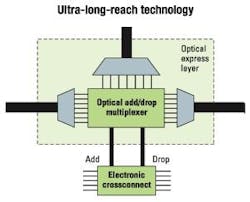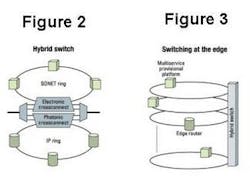Thousand-by-thousand, where art thou?
What happened to those big all-photonic switches? They got hit by a train.
Dr. Denny K. Miu
Integrated Micromachines
With the advent of ULR transport technology, the distance the optical signal can travel can now be extended to as much as 6,000 km (far exceeding the distance between nodes), so traffic can be easily routed through multiple nodes without electrical termination and regeneration. In this architecture, just like the railroad and trains, the nodes are no longer terminals but simple add/drop stations (Figure 1). Furthermore, the network is now segmented into two layers: the top layer being the optical express layer, which is managed by the optical ADM (OADM, a limited form of PXC), and the bottom layer being the service layer, managed by the EXC. As a result, traffic coming into a node is classified into two categories: The first type is express traffic, which is passed through or rerouted to the next node (such that it stays in the express layer), and the second type is for local add/drop, which requires electrical termination and is directed onto the EXC for grooming (where the granularity is STS-1) and local consumption.
This architecture also recognizes that Internet traffic is inherently long-distance, such that on average the sole purpose of about 50% of the traffic that comes to a node is to pass through to another node. As a result, there is a significant cost saving in the construction and operation of an optical network, if unnecessary back-to-back electrical termination/regeneration for transit/express traffic is eliminated.
If the multiplexing/demultiplexing function is integrated with the OADM-type PXC, as is done with most implementations, the port-count requirement can be very small, typically just a few ports corresponding to the number of incoming fibers and add channels (or equivalently, the number of outgoing fibers and drop channels). Since the number of parallel switch planes grows with the number of wavelengths, as the network is built-out, there eventually will be a requirement for a medium-port-count PXC to optically multiplex the add and drop channels to reduce the number of transponders required by the EXC. In any case, the need for thousand-by-thousand PXCs has completely disappeared for this application.
On the other hand, carriers that cannot afford to build a brand new network and still have lots of voice traffic to carry (which is generating a substantial portion of their revenue) tend to endorse a more evolutionary architecture. Unlike two years ago, the purpose of the PXC is no longer to replace the EXC but to coexist with the EXC and complement and enhance its capabilities. In this case, the EXC, with its STS-1 grooming capability, is deployed as the central switching element and essentially the "gateway" between the metro and the LH networks.
The opportunity for PXCs is to address the carriers' need for a multiservice, multiband "hybrid" switch for the metro switching application. A hybrid switch, as described by the carriers, has two switch fabrics (Figure 2). Working with the EXC, the PXC is essentially a "smart" patch panel between the DWDM transport equipment and various peripheral multiservice tributary network elements (to provide express routing or bypass for wavelength-level traffic).
A second opportunity for deploying a hybrid switch (potentially more exciting and more lucrative) is at the access and enterprise end of the network, near the customer premises (Figure 3). In this case, there are usually a large number of TDM SONET rings collecting traffic from tributary network elements such as multiservice provisional platforms (MSPPs), traditional ATM switches, and IP routers. In addition to enabling express routing of wavelength traffic between elements, PXCs can also provide more cost-effective, autonomous, all-optical protection switching.
PXCs are under the same control plane software as the other network elements, so the carriers can remotely provision wavelength services in the metro network using the PXC with the same ease as the EXC. With PXCs, carriers now have additional flexibility for optimizing the network and the ability to eliminate expensive and unnecessary optical-electrical-optical (OEO) conversions whenever and wherever possible, saving significant cost when bypassing expensive and protocol-dependent OEO transponders.
In addition to cost differential, PXCs have the advantage of being transparent to both bit rate and protocol. It is future-proof and can accommodate an ever-changing variety of SONET and non-SONET traffic, which is a unique characteristic of the metro/access environment. With the volume of data traffic still doubling every year, the more cost-effective PXC is clearly an important tool to help the carriers stay competitive.
New role
Aside from the economics, there have been significant technological changes in the last two years in the optical network. In addition to ULR transport and tunable lasers, we have also witnessed a whole host of new network solutions that were not available and perhaps not even imaginable two years ago. For example, Cisco Systems has successfully created an entirely new category of access products with its ONS 15454 MSPPs (acquired from Cerent prior to OFC 2000), which can aggregate lower-speed tributary traffic from the customer premises to wavelength level. Similarly, Ciena has launched its next-generation EXC, the CoreDirector (acquired from Lightera, also prior to OFC 2000), which provides backward compatibility to SONET by electrically aggregating and grooming traffic at STS-1 granularity.
Together, these innovative and cost-effective products have provided much-needed relief for the traffic congestion problems originally meant for PXCs. At the same time, however, these data-friendly networking products have created new market opportunities for PXCs, making it possible to deploy them immediately without first requiring a Herculean effort to overhaul the legacy network architecture, thereby making the success of PXCs more tangible.
While the aforementioned technological changes in the last two years have reduced the port-count requirement for PXCs from thousands to hundreds, as the deployment of PXCs migrates from the core to the service layer to provide wavelength-level services, the potential market in terms of unit requirements has increased from hundreds to tens of thousands.
Therefore, a different future for PXCs has emerged that is perhaps more realistic and commercially more viable than the outlook articulated by the industry two years ago. And we also learned to never forget the railroad and the trains.
Dr. Denny K. Miu is founder and chief technology officer of Integrated Micromachines Inc. (Monrovia, CA).


